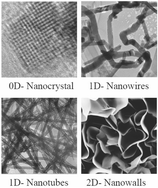Synthesis forms a vital aspect of the science of nanomaterials. In this context, chemical methods have proved to be more effective and versatile than physical methods and have therefore, been employed widely to synthesize a variety of nanomaterials, including zero-dimensional nanocrystals, one-dimensional nanowires and nanotubes as well as two-dimensional nanofilms and nanowalls. Chemical synthesis of inorganic nanomaterials has been pursued vigorously in the last few years and in this article we provide a perspective on the present status of the subject. The article includes a discussion of nanocrystals and nanowires of metals, oxides, chalcogenides and pnictides. In addition, inorganic nanotubes and nanowalls have been reviewed. Some aspects of core–shell particles, oriented attachment and the use of liquid–liquid interfaces are also presented.
You have access to this article
 Please wait while we load your content...
Something went wrong. Try again?
Please wait while we load your content...
Something went wrong. Try again?


 Please wait while we load your content...
Please wait while we load your content...